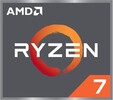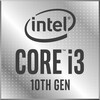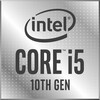AMD Ryzen 7 3780U vs Intel Core i3-10110U vs Intel Core i5-10210U
AMD Ryzen 7 3780U
► remove from comparison
The AMD Ryzen 7 3780U,a Microsoft Surface edition chip, is a mobile SoC that was announced in Oct 2019 as part of the new Surface Laptop 15. It combines four Zen+ cores (8 threads) clocked at 2.3 - 4 GHz with a Radeon RX Vega 11 graphics card with 11 CUs (704 Shaders) clocked at up to 1400 MHz. Specified at 15 Watt TDP, the SoC is intended for thin mid-range laptops.
Compared to the similar Ryzen 7 3700U, the 3780U offers the faster Vega 11 instead of the Vega 10 GPU.
The Picasso SoCs use the Zen+ microarchitecture with slight improvements that should lead to a 3% IPC (performance per clock) improvements. Furthermore, the 12nm process allows higher clock rates at similar power consumptions.
The integrated dual-channel memory controller supports up to DDR4-2400 memory. As the features of the Picasso APUs are the same compared to the Raven Ridge predecessors, we point to our Raven Ridge launch article.
Performance
While we have not tested a single system powered by the 3780U as of August 2023, it's safe to expect the chip to be about as fast as the Ryzen 7 3700U, as far as multi-thread performance is concerned.
Intel Core i3-10110U
► remove from comparison
The Intel Core i3-10110U is a dual-core SoC of the Comet Lake family. The i3 is designed for use in ultraportable laptops of the more affordable flavor as well as mini-PCs. It was announced in August 2019. Just like the other Comet Lake processors, this Core i3 features several advantages over the outgoing Whiskey Lake family including support for faster memory (up to LPDDR4-2933).
Core i3-10110U runs at 2.1 GHz to 4.1 GHz (only 3.7 GHz are reachable when under multi-thread load). Hyper-Threading support is enabled for 4 processing threads in total.
Performance
The average 10110U in our database shapes up to be a decent entry-level CPU, as of late 2021, its multi-thread benchmark scores nearly matching those of the AMD Ryzen 3 3250U and also the Core i3-8145U. While not a whole lot faster than Intel's more affordable Pentium Gold and Pentium Silver chips, the i3 will still let you run most apps with virtually no annoying slowdowns.
Your mileage may vary depending on how high the CPU power limits are and how competent the cooling solution of your system is.
Graphics
The Intel UHD Graphics 620 runs at up to 1,000 MHz. What makes this specific iGPU peculiar is that it only has 23 Execution Units at its disposal, not the 24 EUs typical for a UHD Graphics 620. Otherwise, it's the usual affair with 4K monitor support (up to three displays at the same time) and a hardware video decoder that's friends with VP9, AVC, HEVC but not the newer AV1 video codec.
Power consumption
This Core i3 series chip has a default TDP (also known as the long-term power limit) of 15 W, a value that laptop makers are allowed to change to anything between 10 W and 25 W with clock speeds and performance changing correspondingly. By going for the lowest value, it will be possible to build a passively cooled system around the SoC.
The i3-10110U is built with one of the old 14 nm Intel processees for low, as of early 2023, energy efficiency.
Intel Core i5-10210U
► remove from comparison
The Intel Core i5-10210U is a power efficient quad-core SoC for notebooks based on the Comet Lake (CML-U) generation and was announced in August 2019. Compared to the similar Whiskey Lake processors (e.g. Core i5-8665U), the only difference is support for higher memory speeds (up to LPDDR4-2933 vs DDR4-2400) and two additional cores in the top model (not in this i5). The processor cores are clocked between 1.6 and 4.2 GHz (all 4 cores 3.9 GHz max). Thanks to Hyper-Threading 8 threads can be used. Compared to the faster i5-10510U, the level 3 cache was reduced from 8 to 6 MB. More information on Comet Lake and all the models and articles on it can be found here.
The integrated graphics adapter however is still the same as in the previous generations. It's still called Intel UHD Graphics 620 and clocked from 300 - 1100 MHz in the i5. Furthermore, the SoC integrates a VP9 and H.265 de- and encoder.
Performance
The average 10210U in our database is just as fast as the AMD Ryzen 5 2500U, the Intel Core i7-8565U and the Intel Core i5-1035G1 are, as far as multi-thread benchmark scores are concerned. While the i5 is not a performance monster, it sails through basic day-to-day workloads with little effort.
Thanks to its decent cooling solution and a long-term power limit of 30 W, the Frost Canyon NUC (NUC10i5FNK) is among the fastest systems powered by the 10210U that we know of. It can be more than twice as fast in CPU-bound workloads as the slowest system featuring the same chip in our database, as of August 2023.
Power consumption
This Core i5 series chip has a default TDP, also known as the long-term power limit, of 15 W, a value that laptop makers are free to change to anything between 10 W and 25 W with clock speeds and performance changing accordingly as a result. By going for the lowest value, it is possible to build a passively cooled system around the i5. Please note that Comet Lake-U processors can briefly consume as much as 80 W or even 90 W when under heavy loads.
The Core i5-10210U is built with one of the old 14 nm Intel processes for very low, as of mid 2023, energy efficiency.
| Model | AMD Ryzen 7 3780U | Intel Core i3-10110U | Intel Core i5-10210U | ||||||||||||||||||||||||||||||||||||||||||||||||||||||||||||||||||||||||||||||||||||||||||||||||||||||||
| Codename | Picasso-U (Zen+) | Comet Lake-U | Comet Lake-U | ||||||||||||||||||||||||||||||||||||||||||||||||||||||||||||||||||||||||||||||||||||||||||||||||||||||||
| Series | AMD Picasso (Ryzen 3000 APU) | Intel Comet Lake | Intel Comet Lake | ||||||||||||||||||||||||||||||||||||||||||||||||||||||||||||||||||||||||||||||||||||||||||||||||||||||||
| Series: Comet Lake Comet Lake-U |
|
|
| ||||||||||||||||||||||||||||||||||||||||||||||||||||||||||||||||||||||||||||||||||||||||||||||||||||||||
| Clock | 2300 - 4000 MHz | 2100 - 4100 MHz | 1600 - 4200 MHz | ||||||||||||||||||||||||||||||||||||||||||||||||||||||||||||||||||||||||||||||||||||||||||||||||||||||||
| L1 Cache | 384 KB | 256 KB | 256 KB | ||||||||||||||||||||||||||||||||||||||||||||||||||||||||||||||||||||||||||||||||||||||||||||||||||||||||
| L2 Cache | 2 MB | 1 MB | 1 MB | ||||||||||||||||||||||||||||||||||||||||||||||||||||||||||||||||||||||||||||||||||||||||||||||||||||||||
| L3 Cache | 4 MB | 4 MB | 6 MB | ||||||||||||||||||||||||||||||||||||||||||||||||||||||||||||||||||||||||||||||||||||||||||||||||||||||||
| Cores / Threads | 4 / 8 | 2 / 4 | 4 / 8 | ||||||||||||||||||||||||||||||||||||||||||||||||||||||||||||||||||||||||||||||||||||||||||||||||||||||||
| TDP | 15 Watt | 15 Watt | 15 Watt | ||||||||||||||||||||||||||||||||||||||||||||||||||||||||||||||||||||||||||||||||||||||||||||||||||||||||
| Transistors | 4500 Million | ||||||||||||||||||||||||||||||||||||||||||||||||||||||||||||||||||||||||||||||||||||||||||||||||||||||||||
| Technology | 12 nm | 14 nm | 14 nm | ||||||||||||||||||||||||||||||||||||||||||||||||||||||||||||||||||||||||||||||||||||||||||||||||||||||||
| max. Temp. | 105 °C | 100 °C | 100 °C | ||||||||||||||||||||||||||||||||||||||||||||||||||||||||||||||||||||||||||||||||||||||||||||||||||||||||
| Socket | FP5 | BGA1528 | BGA1528 | ||||||||||||||||||||||||||||||||||||||||||||||||||||||||||||||||||||||||||||||||||||||||||||||||||||||||
| Features | DDR4-2400 RAM, PCIe 3, MMX (+), SSE, SSE2, SSE3, SSSE3, SSE4.1, SSE4.2, SSE4A, AES, AVX, AVX2, FMA3, SHA | LPDDR3-2133/DDR4-2666/LPDDR4-2933 RAM, PCIe 3, 4 GT/s bus, MMX, SSE, SSE2, SSE3, SSSE3, SSE4.1, SSE4.2, AVX, AVX2, BMI2, ABM, FMA, ADX, VMX, SMEP, SMAP, MPX, EIST, TM1, TM2, Hyper-Threading, Turbo, SST, AES-NI, RDRAND, RDSEED, SGX | LPDDR3-2133/DDR4-2666/LPDDR4-2933 RAM, PCIe 3, 4 GT/s bus, MMX, SSE, SSE2, SSE3, SSSE3, SSE4.1, SSE4.2, AVX, AVX2, BMI2, ABM, FMA, ADX, VMX, SMEP, SMAP, MPX, EIST, TM1, TM2, Hyper-Threading, Turbo, SST, AES-NI, RDRAND, RDSEED, SGX | ||||||||||||||||||||||||||||||||||||||||||||||||||||||||||||||||||||||||||||||||||||||||||||||||||||||||
| iGPU | AMD Radeon RX Vega 11 ( - 1400 MHz) | Intel UHD Graphics 620 (300 - 1000 MHz) | Intel UHD Graphics 620 (300 - 1100 MHz) | ||||||||||||||||||||||||||||||||||||||||||||||||||||||||||||||||||||||||||||||||||||||||||||||||||||||||
| Architecture | x86 | x86 | x86 | ||||||||||||||||||||||||||||||||||||||||||||||||||||||||||||||||||||||||||||||||||||||||||||||||||||||||
| Announced | |||||||||||||||||||||||||||||||||||||||||||||||||||||||||||||||||||||||||||||||||||||||||||||||||||||||||||
| Manufacturer | www.amd.com | ark.intel.com | ark.intel.com |
Benchmarks
Average Benchmarks AMD Ryzen 7 3780U → 100% n=8
Average Benchmarks Intel Core i3-10110U → 84% n=8
Average Benchmarks Intel Core i5-10210U → 107% n=8
* Smaller numbers mean a higher performance
1 This benchmark is not used for the average calculation













